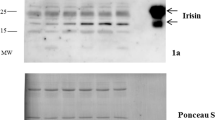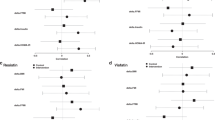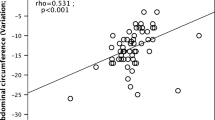Abstract
Objective:
The aim of our study was to determine whether eating behaviors and/or physical activity level may explain contradicting results in adipocytokines levels in anorexia nervosa (AN).
Subjects/Methods:
Fasting levels of circulating adipocytokines (adiponectin, resistin and leptin), insulin, glucose, C-reactive protein, cytokines (tumor necrosis factor-α and interleukin (IL)-1β), body composition and resting energy expenditure were measured in 24 women AN patients and 14 women controls. These parameters were compared according to AN subtypes: 15 patients with restrictive (R-AN) form versus 9 patients with binge/purge (BP-AN) form; 15 patients with hyperactive (H-AN) form versus 9 patients with nonhyperactive (NH-AN) form.
Results:
BP-AN patients had significantly higher serum adiponectin levels compared with R-AN patients (P<0.05), and H-AN patients had higher serum leptin and lower serum resistin levels compared with NH-AN patients (P<0.05 for both).
Conclusions:
Our study shows specific adipocytokines profiles depending on the subtype of AN: restrictive versus binge/purge and hyperactive versus Nonhyperactive forms. We suggest that these biological signatures could interfere with the outcome of the disease.
This is a preview of subscription content, access via your institution
Access options
Subscribe to this journal
Receive 12 print issues and online access
$259.00 per year
only $21.58 per issue
Buy this article
- Purchase on Springer Link
- Instant access to full article PDF
Prices may be subject to local taxes which are calculated during checkout
Similar content being viewed by others
References
American Psychiatric Association (1994). Diagnosic and Statistical Manual of Mental Disorders 4th edn. American Psychiatric Press: Washington, DC.
Brambilla F (2001). Social stress in anorexia nervosa: a review of immuno-endocrine relationships. Physiol Behav 73, 365–369.
Brambilla F, Monti D, Franceschi C (2001). Plasma concentrations of interleukin-1-beta, interleukin-6 and tumor necrosis factor-alpha, and of their soluble receptors and receptor antagonist in anorexia nervosa. Psychiatry Res 103, 107–114.
Brichard SM, Delporte ML, Lambert M (2003). Adipocytokines in anorexia nervosa: a review focusing on leptin and adiponectin. Horm Metab Res 35, 337–342.
Davis C, Katzman DK, Kaptein S, Kirsh C, Brewer H, Kalmbach K et al. (1997). The prevalence of high-level exercise in the eating disorders: etiological implications. Compr Psychiatry 38, 321–326.
Delporte ML, Brichard SM, Hermans MP, Beguin C, Lambert M (2003). Hyperadiponectinaemia in anorexia nervosa. Clin Endocrinol (Oxf) 58, 22–29.
Dolezalova R, Lacinova Z, Dolinkova M, Kleiblova P, Haluzikova D, Housa D et al. (2007). Changes of endocrine function of adipose tissue in anorexia nervosa: comparison of circulating levels versus subcutaneous mRNA expression. Clin Endocrinol (Oxf) 67, 674–678.
Dostalova I, Kunesova M, Duskova J, Papezova H, Nedvidkova J (2006). Adipose tissue resistin levels in patients with anorexia nervosa. Nutrition 22, 977–983.
Dostalova I, Smitka K, Papezova H, Kvasnickova H, Nedvidkova J (2007). Increased insulin sensitivity in patients with anorexia nervosa: the role of adipocytokines. Physiol Res 56, 587–594.
Eddy KT, Keel PK, Dorer DJ, Delinsky SS, Franko DL, Herzog DB (2002). Longitudinal comparison of anorexia nervosa subtypes. Int J Eat Disord 31, 191–201.
Hebebrand J, Exner C, Hebebrand K, Holtkamp C, Casper RC, Remschmidt H et al. (2003). Hyperactivity in patients with anorexia nervosa and in semistarved rats: evidence for a pivotal role of hypoleptinemia. Physiol Behav 79, 25–37.
Hebebrand J, Muller TD, Holtkamp K, Herpertz-Dahlmann B (2007). The role of leptin in anorexia nervosa: clinical implications. Mol Psychiatry 12, 23–35.
Holtkamp K, Hebebrand J, Herpertz-Dahlmann B (2004a). The contribution of anxiety and food restriction on physical activity levels in acute anorexia nervosa. Int J Eat Disord 36, 163–171.
Holtkamp K, Hebebrand J, Mika C, Heer M, Heussen N, Herpertz-Dahlmann B (2004b). High serum leptin levels subsequent to weight gain predict renewed weight loss in patients with anorexia nervosa. Psychoneuroendocrinology 29, 791–797.
Holtkamp K, Herpertz-Dahlmann B, Hebebrand K, Mika C, Kratzsch J, Hebebrand J (2006). Physical activity and restlessness correlate with leptin levels in patients with adolescent anorexia nervosa. Biol Psychiatry 60, 311–313.
Housova J, Anderlova K, Krizova J, Haluzikova D, Kremen J, Kumstyrova T et al. (2005). Serum adiponectin and resistin concentrations in patients with restrictive and binge/purge form of anorexia nervosa and bulimia nervosa. J Clin Endocrinol Metab 90, 1366–1370.
Iwahashi H, Funahashi T, Kurokawa N, Sayama K, Fukuda E, Okita K et al. (2003). Plasma adiponectin levels in women with anorexia nervosa. Horm Metab Res 35, 537–540.
Jones TE, Basilio JL, Brophy PM, McCammon MR, Hickner RC (2009). Long-term exercise training in overweight adolescents improves plasma peptide YY and resistin. Obesity 17, 1189–1195.
Lowe B, Zipfel S, Buchholz C, Dupont Y, Reas DL, Herzog W (2001). Long-term outcome of anorexia nervosa in a prospective 21-year follow-up study. Psychol Med 31, 881–890.
Matthews DR, Hosker JP, Rudenski AS, Naylor BA, Treacher DF, Turner RC (1985). Homeostasis model assessment: insulin resistance and beta-cell function from fasting plasma glucose and insulin concentrations in man. Diabetologia 28, 412–419.
Monteleone P, Fabrazzo M, Martiadis V, Fuschino A, Serritella C, Milici N et al. (2003). Opposite changes in circulating adiponectin in women with bulimia nervosa or binge eating disorder. J Clin Endocrinol Metab 88, 5387–5391.
Monteleone P, Castaldo E, Maj M (2008). Neuroendocrine dysregulation of food intake in eating disorders. Regul Pept 149, 39–50.
Nakai Y, Hamagaki S, Takagi R, Taniguchi A, Kurimoto F (1999). Plasma concentrations of tumor necrosis factor-alpha (TNF-alpha) and soluble TNF receptors in patients with anorexia nervosa. J Clin Endocrinol Metab 84, 1226–1228.
Nova E, Gomez-Martinez S, Morande G, Marcos A (2002). Cytokine production by blood mononuclear cells from in-patients with anorexia nervosa. Br J Nutr 88, 183–188.
Pannacciulli N, Vettor R, Milan G, Granzotto M, Catucci A, Federspil G et al. (2003). Anorexia nervosa is characterized by increased adiponectin plasma levels and reduced nonoxidative glucose metabolism. J Clin Endocrinol Metab 88, 1748–1752.
Rubin DA, McMurray RG, Harrell JS, Thorpe DE, Hackney AC (2008). Vigorous physical activity and cytokines in adolescents. Eur J Appl Physiol 103, 495–500.
Steinhausen HC, Grigoroiu-Serbanescu M, Boyadjieva S, Neumarker KJ, Winkler Metzke C (2008). Course and predictors of rehospitalization in adolescent anorexia nervosa in a multisite study. Int J Eat Disord 41, 29–36.
Stoving RK, Hangaard J, Hansen-Nord M, Hagen C (1999). A review of endocrine changes in anorexia nervosa. J Psychiatr Res 33, 139–152.
Tagami T, Satoh N, Usui T, Yamada K, Shimatsu A, Kuzuya H (2004). Adiponectin in anorexia nervosa and bulimia nervosa. J Clin Endocrinol Metab 89, 1833–1837.
Thompson-Brenner H, Eddy KT, Franko DL, Dorer D, Vashchenko M, Herzog DB (2008). Personality pathology and substance abuse in eating disorders: a longitudinal study. Int J Eat Disord 41, 203–208.
Zou C, Shao J (2008). Role of adipocytokines in obesity-associated insulin resistance. J Nutr Biochem 19, 277–286.
Acknowledgements
We thank Myriam Coffin for her technical help.
Author information
Authors and Affiliations
Corresponding author
Ethics declarations
Competing interests
The authors declare no conflict of interest.
Rights and permissions
About this article
Cite this article
Nogueira, JP., Maraninchi, M., Lorec, AM. et al. Specific adipocytokines profiles in patients with hyperactive and/or binge/purge form of anorexia nervosa. Eur J Clin Nutr 64, 840–844 (2010). https://doi.org/10.1038/ejcn.2010.66
Received:
Revised:
Accepted:
Published:
Issue Date:
DOI: https://doi.org/10.1038/ejcn.2010.66
Keywords
This article is cited by
-
Adiponectin in eating disorders
Eating and Weight Disorders - Studies on Anorexia, Bulimia and Obesity (2014)
-
Impact of exercise on energy metabolism in anorexia nervosa
Journal of Eating Disorders (2013)
-
Tumour necrosis factor alpha and oxidative stress as maintaining factors in the evolution of anorexia nervosa
Eating and Weight Disorders - Studies on Anorexia, Bulimia and Obesity (2012)



